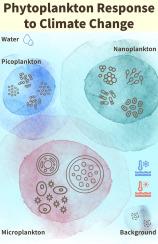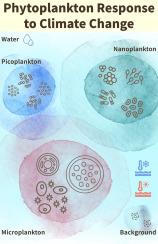将生态概念与海洋颜色模型相结合:参数化和前瞻性建模
IF 11.1
1区 地球科学
Q1 ENVIRONMENTAL SCIENCES
引用次数: 0
摘要
在本系列论文的第一部分(Sun 等人,2023 年)中,我们建立了一个生态模型,将总叶绿素-a 浓度(Chl-a)划分为三个浮游植物大小等级(PSCs),即皮米级、纳米级和微型浮游植物。该模型的参数受海面温度(SST)控制,旨在捕捉浮游植物大小结构的变化,而不受总叶绿素-a变化的影响。在本系列的第二部分,我们将介绍一个海洋颜色建模框架(OCMF),它建立在经典的案例-1 假设基础上,明确纳入了我们的生态模型。OCMF 假设存在三种 PSC 以及独立的非藻类颗粒背景。该框架假定每个浮游植物群都处于不同的光学环境中,并直接(浮游植物)和间接(非藻类颗粒和溶解物质)为每个浮游植物群赋予叶绿素特定的固有光学特性。OCMF 通过一个大型全球固有光学特性和表观光学特性数据集进行参数化、验证和评估。我们利用 OCMF 探索温度和 Chl-a 变化对浮游植物大小结构的影响,以及由此对海洋颜色的影响。我们还讨论了 OCMF 的应用,如其在反演建模和浮游植物气候趋势探测方面的潜力,这些将在后续论文中进一步探讨。本文章由计算机程序翻译,如有差异,请以英文原文为准。


Coupling ecological concepts with an ocean-colour model: Parameterisation and forward modelling
In the first part of this paper series (Sun et al., 2023), we developed an ecological model that partitions the total chlorophyll-a concentration (Chl-a) into three phytoplankton size classes (PSCs), pico-, nano-, and microplankton. The parameters of this model are controlled by sea surface temperature (SST), intended to capture shifts in phytoplankton size structure independently of variations in total Chl-a. In this second part of the series, we present an Ocean Colour Modelling Framework (OCMF), building on the classical Case-1 assumption, that explicitly incorporates our ecological model. The OCMF assumes the presence of the three PSCs and the existence of an independent background of non-algal particles. The framework assumes each phytoplankton group resides in a distinct optical environment, assigning chlorophyll-specific inherent optical properties to each group, both directly (phytoplankton) and indirectly (non-algal particulate and dissolved substances). The OCMF is parameterised, validated, and assessed using a large global dataset of inherent and apparent optical properties. We use the OCMF to explore the influence of variations in temperature and Chl-a on phytoplankton size structure and its resulting effects on ocean colour. We also discuss applications of the OCMF, such as its potential for inverse modelling and phytoplankton climate trend detection, which will be explored further in subsequent papers.
求助全文
通过发布文献求助,成功后即可免费获取论文全文。
去求助
来源期刊

Remote Sensing of Environment
环境科学-成像科学与照相技术
CiteScore
25.10
自引率
8.90%
发文量
455
审稿时长
53 days
期刊介绍:
Remote Sensing of Environment (RSE) serves the Earth observation community by disseminating results on the theory, science, applications, and technology that contribute to advancing the field of remote sensing. With a thoroughly interdisciplinary approach, RSE encompasses terrestrial, oceanic, and atmospheric sensing.
The journal emphasizes biophysical and quantitative approaches to remote sensing at local to global scales, covering a diverse range of applications and techniques.
RSE serves as a vital platform for the exchange of knowledge and advancements in the dynamic field of remote sensing.
 求助内容:
求助内容: 应助结果提醒方式:
应助结果提醒方式:


